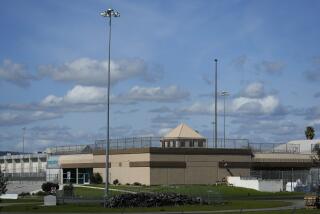Report faults prison care of state’s mentally ill inmates
A federal court official says that treatment of California’s most severely mentally ill prisoners is haphazard and often inadequate, delivered by a fractured, understaffed system in which doctors discharge patients because they are afraid not to.
The report, filed in U.S. District Court on Friday by special master Matthew Lopes, chronicles an eight-month investigation of conditions at two state psychiatric hospitals and the psychiatric hospitals run within four state prisons.
Only one program, at the California Institution for Women, was considered to be meeting patients’ needs.
Lopes described care elsewhere that was “more rote than truly responsive.” He said some patients were returned to prison too soon, drugged instead of counseled and only rarely given one-on-one therapy.
What was counted as “group therapy” at one prison included participation in a magazine lending program
A spokeswoman for the California Department of Corrections and Rehabilitation declined to comment other than to note the relatively good marks given to the women’s prison.
“We are encouraged by what the Special Master found at CIW, and we are committed to continuing to improve care for mentally ill inmates in our institutions,” Deborah Hoffman said in an emailed reply.
She declined to address conditions for prisoners at five other facilities, three of which are run on the grounds of state prisons, saying that they are the sole responsibility of the Department of State Hospitals. Lopes, however, characterized them as jointly run by the two state agencies.
A state hospitals spokesman had little comment Friday. “The Department of State Hospitals has received the report and is reviewing it,” said the spokesman, Ken August.
The special master’s report was ordered last year by U.S. District Judge Lawrence Karlton after he rejected California’s bid to end federal oversight of prison psychiatric care and ruled that inmate care still failed to meet levels required by the Constitution.
Lopes suggests that the state continue on-site monitoring of four of the psychiatric facilities.
Some of the harshest criticisms were reserved for Atascadero State Hospital, where a paroled prisoner receiving psychiatric treatment was accused of killing another patient this week.
The hospital was under federal oversight from 2006 to November 2011. Lopes reported that when the watch ended, staffing levels immediately dropped, as did access to group therapy.
Atascadero was also singled out for discharging prisoners based on their length of stay rather than their mental condition.
One hallucinating inmate was returned to prison days after assaulting hospital workers in what Lopes called a “seemingly precipitous decision” rarely appropriate for someone who is actively psychotic.
He reported that psychiatrists feared reprisal from administrators if they did not sign discharge papers, even when they believed the prisoners should stay.
Another prisoner was sent to Atasacadero for trying to kill himself after the sudden death of his son. Lopes criticized the hospital for failing to provide grief counseling and for putting the man instead into counseling to address drug abuse and anger management.
The prisoner had no history of drug use and had shown no aggressive behavior, the report said.
All six psychiatric centers were in the process of trying to make improvements, Lopes noted. He said “the landscape of inpatient care for [California prison] inmates is evolving.”
But he said treatment was often inadequate and generic, with disregard for individual problems.
“There is a need for the development of a consistent, more therapeutically oriented and less punitively oriented system that can be applied across all six programs,” he wrote.
Most care at the state hospitals was delivered through group sessions, but Lopes found some patients received as little as an hour a month. “Patients also complained of having no one to talk to when they were having difficulties,” Lopes said.
Individual therapy was rare, even if a prisoner’s condition dictated that he be seen alone. Prisoners at one hospital said that if they sought individual treatment, they were more likely to be prescribed medication instead.
Staffing shortages were a problem at three facilities. At Atascadero, they fell so low after federal oversight ended in 2011 that hospital administrators adopted a “crisis” plan in September that shifted duties to other workers that were supposed to be performed by psychiatrists.
At the Salinas Valley psychiatric hospital, half of the psychologists and social workers were unlicensed.
Atascadero records showed that patients’ access to group therapy sessions had dropped from 12 a week in 2011 to seven in late 2013. However, Lopes reported that attendance records indicated the number was actually four hours a week.
Atascadero workers credited the end of federal oversight for a large decline in patient assaults and other violent behavior. Lopes reported that clinicians felt fewer restrictions on using psychotropic drugs, seclusion and restraints to curb violence among patients.
He wrote that patients were strapped to their beds 76 times during an eight-month period in 2013, usually for less than 24 hours, but in some cases for nearly four days.
More to Read
Start your day right
Sign up for Essential California for news, features and recommendations from the L.A. Times and beyond in your inbox six days a week.
You may occasionally receive promotional content from the Los Angeles Times.







